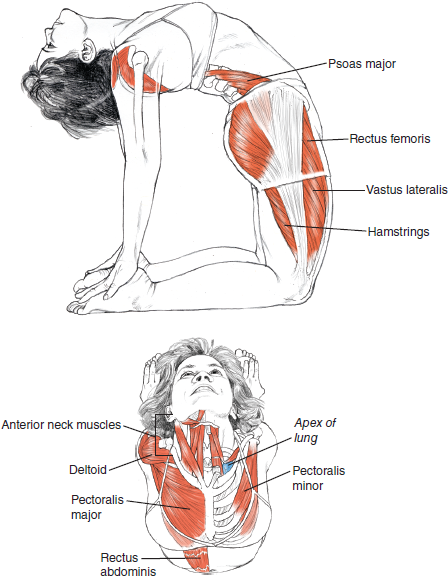Biomechanics: Ustrasana (Camel Pose)

Figure taken from Kaminoff &
Matthews 2012
The camel pose is an interesting back bend in that the spine
acts a bit like a spring that has gone from an equilibrium
position into compression.
Ideally this pose is approached with a relatively flexible
spine, where the yogi (yoga practitioner) tries to keep the
front body muscles (psoas major) more static
than other muscles. Keeping the psoas almost as long and
uncompressed as when kneeling upright, while focusing the main
contracting forces in the iliacus (hip crease
muscles), lower abdomen muscles, and the rectus
femoris, helps protect the spine from
over arching.
One factor in achieving this asana may be the stiffness of
the connective tissues between the vertebrae of the spine.
This relates to the spring
constant and Hooke's Law,
a model of a restoring force that
equals the change in position (displacement)
multiplied by the spring constant (Knight 2013). Here,
the spring constant is the ratio of the force it takes to bend
the spine to the displacement created from rest (when the
practitioner is kneeling straight up and the spine is in its
natural position). In this case, spine movement may be thought
of as a complicated type of spring compression, and the larger
the spring constant in the spine, the stiffer the connective
tissues. An individual practitioner's spine will differ based
on anatomy and density of the fascia
(connective tissues) between the vertebrae.
The arms in this pose should be acting as a support force pushing up gently, opposite the force of gravity, preventing the practitioner's back from moving closer to the floor. This is achievable when the spring constant of a practitioner's connective tissues between spinal vertebrae is low enough (soft or flexible enough) for this range of movement. If the arms are used in such a manner that they provide a tensile force downward (excessive gripping of heels by the hands), in the same direction as gravity, and opposite that of the net force in the spine and front body muscles, this can be unhealthy for the body. If this is the case for an individual, the alternative is to place the hands on the sacrum (lower back just above the tail bone), and enter the back bend only as far as the spine allows. With practice, the spring constant of the connective tissues may lower enough to allow the arms to become an upward support force and not a downward tensile force.Gravity is pulling the torso into the back bend, which is checked by the arm action and the eccentric action of the spinal flexors. In the cervical spine, the anterior neck muscles are eccentrically active, but the sternocleidomastoid should not be active to avoid the base of the skull being pulled into the atlas and axis. Internal rotation of the legs will help stabilize the SI joint by encouraging the front of this joint to align. It helps to focus on releasing the sternocleidomastoid using the eccentric strength of deeper anterior neck muscles to stabilize weight of the head.
(Kaminoff & Matthews 2012)